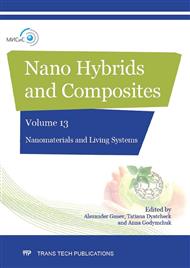[1]
I. Kulikov, I. Minakov, Food safety in the production and consumption of fruits and vegetables, J. AIC: Economics, Management 2 (2016) 4-16.
Google Scholar
[2]
I.N. Budzalov, The weak link in the national security system of Russia. Intern. agricultural Journal 5 (2012) 3-9.
Google Scholar
[3]
I.A. Minakov, A.V. Beketov, A.V. Zyuzya, The efficiency of production of greenhouse vegetables. J. Herald MichGAU 2 (2006) 111-119.
Google Scholar
[4]
K.A. Timiryazev, Sun Life and Chlorophyll, Selkhozgiz, Moscow, (1948).
Google Scholar
[5]
A.A. Tikhomirov, G.M. Lisowski, F.Y. Sidko, The spectral composition of light and plant productivity, Nauka, Novosibirsk, (1991).
Google Scholar
[6]
I.A. Shulgin, The plant and the sun, Gidrometeoizdat, Saint-Petersburg, (1973).
Google Scholar
[7]
A.F. Kleshnin, Plants and lights. Theory and practice of plant photoculture, Publishing House of the USSR Academy of Sciences, Moscow, (1954).
Google Scholar
[8]
V.N. Volkov, I.I. Sventitsky, P.I. Storozhev, L.A. Tsarev Artificial irradiation plants, Pushchino, (1982).
Google Scholar
[9]
B.S. Moshkov, Growing plants under artificial lighting, Kolos, Moscow, (1966).
Google Scholar
[10]
L.G. Prishchep, Efficient electrification of the protected ground, Kolos, Moscow, (1980).
Google Scholar
[11]
A.G. Molchanov, V.V. Samoilenko, Energy-saving optical irradiation industrial greenhouses, ARGUS, Stavropol, (2013).
Google Scholar
[12]
V.M. Lehman, Course photoculture plants, Higher School, Moscow, (1976).
Google Scholar
[13]
A.A. Ilyin, Spectra of absorption and reflection of the leaves of plants, J. Physical Chemistry, T. 21 2 (1947) 145-159.
Google Scholar
[14]
E.V. Shpolsky, Chlorophyll absorption spectrum in solution and in the natural state, J Herald USSR Academy of Sciences, Biology Series 3 (1947) 397-406.
Google Scholar
[15]
V.S. Rayda, E.O. Kowal, A.S. Minich, A.V. Akimov, G.A. Tolstikov, Absorption of UV radiation polyethylene films with additives photo-based phosphors europium compounds, J. Plastics, 3 (2001) 31-32.
Google Scholar
[16]
V.S. Rayda, E.O. Kowal, A.E. Ivanitskii, O.S. Andrienko, G.A. Tolstikov, Features of the luminescent properties of polyethylene films with additives photoluminophors based on europium compounds. J. Plastics, 12 (2001) 39-41.
Google Scholar
[17]
GOST 28205-89 (IEC 68-2-9-75) Interstate standard. Basic methods of testing the effects of external factors. Part 2: Tests. Guide to test the effects of solar radiation.
Google Scholar
[18]
V.E. Karasev, Polisvetany - new polymeric light transforming materials for agriculture, Bulletin of the Far Eastern Branch of the Russian Academy of Sciences, 2 (1995) 66-73.
Google Scholar
[19]
S.I. Kusnetsov, G.V. Leplianin, U.I. Murinov, Polisvetan, a high performance material for cladding grinhouses. J. Plasticulture, T. 3 83 (1989) 13-20.
Google Scholar
[20]
V.S. Rayda, A.E. Ivanitskii, E.A. Mayer, G.A. Tolstikov, Features light transmittance fluorescent PVC film with phosphors based on europium complexes, J. Plastics, 12 (2002) 35-39.
Google Scholar
[21]
V.S. Rayda A.E. Ivanitskii, A.V. Bushkov, O.S. Andrienko, G.A. Tolstikov, The study features the conversion of the sun UV radiation and visible ranges of the fluorescent films with phosphors based on europium compounds, J. Optics of atmosphere and ocean, T. 16 2 (2003).
Google Scholar
[22]
H.G. Tooming, B.I. Gulyaev, The measurement method of photosynthetically active radiation, Nauka, Moscow, (1967).
Google Scholar
[23]
K. Ya. Kondratev, Actinometers, Hydrometeorological Publishing House, Saint-Petersburg, (1965).
Google Scholar
[24]
Yu.B. Eisenberg, Handbook of Illumination, Energoatomisdat, Moscow, (1983).
Google Scholar
[25]
S.I. Sivkov, Calculation methods of solar radiation characteristics, Hydrometeorological Publishing House, Saint-Petersburg, (1968).
Google Scholar
[26]
A.B. Brandt, The use of efficient units, J. Light engineering, 1 (1980) 24-26.
Google Scholar
[27]
H.G. Tooming, Solar radiation and the formation of the crop, Hydrometeorological Publishing House, Saint-Petersburg, (1977).
Google Scholar
[28]
H. Tooming, H. Niylisk, Conversion factor from integrated radiation to the FAS in vivo. Photoactinometrical study of vegetation, Valgus, Tallinn, (1967).
Google Scholar
[29]
S.A. Pavlov, V.V. Krikushenko, E.M. Antipov, N.B. Voronets, E. Yu. Maksimova, N.E. Sherstneva, S.L. Koriakin. Light output and efficiency of fluorescent polymer layers containing colloidal semiconductor phosphors based on quantum dots CdSe/CdS/ZnS, J. Optics and Spectroscopy, T. 119 2 (2015).
DOI: 10.1134/s0030400x15080172
Google Scholar
[30]
S.A. Pavlov, E. Yu. Maksimova, S.L. Koriakin, N.E. Sherstneva, E.M. Antipov, Evaluation of subpixels luminescent luminosity monitor based on quantum dots CdSe/CdS/ZnS, J. Russian Nanotechnologies, T. 11 3 (2016) 64 - 68.
DOI: 10.1134/s1995078016020142
Google Scholar


